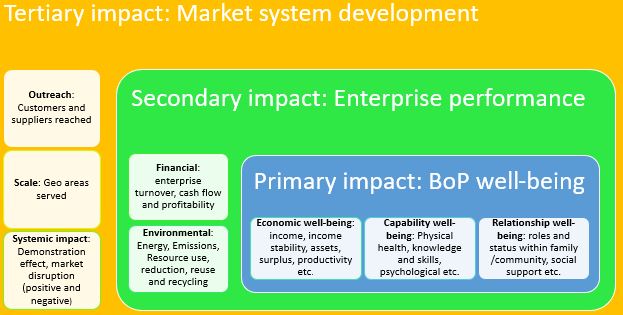Innovation is not about technology alone. Innovation is about the process of using ideas (novel or otherwise) in new ways and combinations, for economic, social and/or environmental gain.
Innovations can take different forms, including technological (probably the most obvious), organizational, business, social and policy. They also can involve overarching systems. This understanding is critically important when evaluating innovation.
Business innovations can have a profound impact on low-income populations, sometimes referred to as Base of Pyramid (BoP) populations. These innovations may be designed to address development problems faced by BoP populations, such as smallholders (<0.5 ha land) who lack access to essential extension services, market access, modern farming inputs, technology and finance. They may take the form of a product (e.g., low cost solar drier for crops), a technology (climate smart technology for aquifer recharge), or an application (IT app that connects farmers to markets or digitizes extension and agriculture supply chains). Ultimately, business innovations can have multiplier effects, reaching large numbers of smallholders, increasing their crop yields and incomes and, at the same time, helping businesses to perform better financially and become more environment friendly. Clearly, all of these aspects would need to be understood and evaluated through appropriate metrics and tools.
Evaluating business innovations
At Natural Resources Institute, we developed the Social Venture Impact Metric (SVIM) to assess three types of impact resulting from innovation (see the figure below). This metric provided us with a method and tools geared specifically towards agribusiness and other sectors.
In SVIM, three levels of impact are measured:
1) Primary, the impact of innovation on low income/BoP populations;
2) Secondary, the impact of innovation partnerships, which could be at the enterprise level, and measured through assessing both financial and environmental performance of the business;
3) Tertiary impact, which is realized when the innovation is able to catalyse market-level change. This means achieving greater outreach and a critical scale in the market and /or accelerating the development of a market that reaches an underserved or disadvantaged population. It also means understanding the ‘market-disruption’ (both positive and negative) potential of the innovation.
Tertiary impacts bring much more systemic change, leading larger numbers of businesses and policy programmes to learn from the innovation and join the bandwagon. Positive market system development can usher in local economic development and social domino effects. Market-level systemic impact is possible, even though much harder to achieve and to measure.
The tool for measuring primary impact (at BoP level) in SVIM comes from the BoP Impact Assessment Framework. This approach was developed by William Davidson Institute at the University of Michigan to measure performance at social ventures.
Experiences so far…
SVIM has been developed and used for two large programme evaluations to date – DFID INVENT Global programme and Africa Enterprise Challenge Fund – Research into Business Window. Its design was driven by the goal of the programme in terms of innovative products and services for addressing a specific need or a development challenge. To granularly develop SVIM, the impact of an innovation product or service at any of /all three levels – BoP, enterprise, and market – was conceptualized with specific indicators and measurement tools (which be shared with those interested). To do so, the evaluation team conducted participative strategic analysis with several businesses and with a cross section of BoP stakeholders (customers, employees, producers, supplier, and community).
The table below provides an example of a range of indicators, inspired by Impact Reporting and Investment Standard (IRIS), and developed for a particular agribusiness in digital agriculture supply chain:
| Primary impact (BoP) | Secondary impact (enterprise) | Tertiary impact (Market) |
|---|---|---|
Economic well-being: Average agricultural production and income per hectare of small holders; Average decrease in input costs on account of the intervention; Volume purchased from smallholders etc. | Financial performance: turnover, cash flow, profitability of the business venture | Customer reach: Farmers and entrepreneurs registered in an agri hub app |
Capability well-being: knowledge and skill enhancement at producer and entrepreneur levels in terms of production and marketing aspects | Environmental performance: Amount of energy saving, emissions avoided; volume of water savings per ha. by farmers through use of technology promoted by the app | Geographic area served: number of markets and market segments reached by the app |
| Relationship well-being: change in status of women and youth in roles at family and community levels | Systemic: Increase in entrepreneur income and a functioning app impacting the way the agribusiness is conducted; adoption of IT app at village level leading to increase in agriculture production |
Similar exercises were done for a range of business innovations linked to the two large programme evaluations mentioned above.
Not without challenges…
Measuring the impact of innovations, especially business innovations in agriculture and natural resources management, is a new emerging field and offers several challenges. We had limited success in gaining access to data on financial, environmental, and social performance as many businesses did not capture this data systematically or were unwilling to share their data. Therefore, in addition to primary data and assessments, available secondary data was used to generate insights and inferences. While SVIM gathered a wide range of data and perceptions regarding impact of business innovations, it was not possible to robustly quantify and statistically signify the impacts in all cases, though SVIM methodology has shown potential in calculating Value for Money (VfM) or Social Return on Investment (SROI).
Despite the challenges, evaluations in this area can help to shed light on and draw attention to the potential for tailored solutions which business innovations may offer in addressing poverty, food and nutrition insecurity. The authors would be happy to share specific metrics and tools developed for capturing data on the above indicators.
---
Resources:
Making Better Investments at the Base of the Pyramid - William Davidson Institute at the University of Michigan - hbr.org/2009/05/making-better-investments-at-the-base-of-the-pyramid
Value for money metrics – Technical Guidance note - www.gov.uk/government/publications/value-for-money-metrics-technical-note
Social Return on Investment - www.betterevaluation.org/en/approach/SROI
Impact Reporting and Investment Standards - iris.thegiin.org

